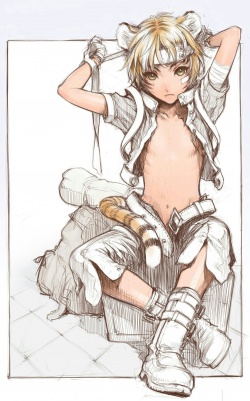Manga and anime
Manga (漫画) are comics created in Japan, or by Japanese creators in the Japanese language, conforming to a style developed in Japan in the late 19th century. They have a long and complex pre-history in earlier Japanese art. [1]
Anime (アニメ?, [anʲime] are Japanese animated productions featuring hand-drawn or computer animation. The word is the abbreviated pronunciation of "animation" in Japanese, where this term references all animation. In other languages, the term is defined as animation from Japan or as a Japanese-disseminated animation style often characterized by colorful graphics, vibrant characters and fantastic themes. Arguably, the stylization approach to the meaning may open up the possibility of anime produced in countries other than Japan. For simplicity, many Westerners strictly view anime as an animation product from Japan. [2]
Shotacon

Shotacon, Shota, and Yaoi are words that are used to describe a type of Japanese art that depict same-sex relationships between boys and sometimes between men and boys. The boys depicted in these graphic novels or anime are extremely effeminate and have been described as “girls with dicks”. [3] Typically the boys dress in girl’s clothes, have girl’s hairstyles, and are often mistaken by the protagonist to be a girl.
It is also quite common for the boys in these comic books to be given catlike features most often cat ears and sometimes cat tails as well (as depicted on the image left). They are sometimes described as Uke. Uke is used in Japanese gay slang to mean the receptive partner in anal sex[4]
Boku no Pico (My Pico) is the first installment of a series of three Japanese adult shotacon anime produced by Natural High. The producer has described it as "the world's first" shotacon anime (animated cartoon). [3] Boku no Pico would be considered as a typical example of this genre of art. It is the story of Tamotsu, who first sees Pico swimming nude (rear view) from a distance and latter encounters him working at his grandfather’s bar. Tamotsu believes Piko to be a young girl and doesn’t discover his mistake until their first sexual encounter. Their relationship continues to develop as Tamotsu attempts to keep Pico girlish by dressing him in female clothing. Because of this and Tamotsu’s refusal to define their relationship, Pico runs away from Tamotsu and cuts his hair and puts on boys clothes. Tamotsu eventually finds Piko and they reconcile and in the end are shown playing and splashing in the sea.
In Japan, 50-60% of the readership of these magazines are heterosexual females [4] However, because of the current sexual hysteria in the western culture towards the sexuality of people under 18, it is uncertain if this type of art has a future even in Japan. It is almost certainly illegal to possess this art in the USA, Canada, Germany, Netherlands, Sweden, Norway, Australia, New Zealand and the UK, remaining legal in countries like Spain or Italy[5] [6]